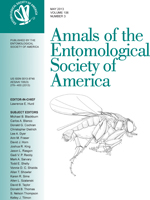Pediobius ni Peck (Hymenoptera: Eulophidae) is a eulophid parasitoid indigenous to North America that was found attacking the invasive light brown apple moth, Epiphyas postvittana (Walker) (Lepidoptera: Tortricidae), in California. We investigated host age suitability, fecundity, and temperature-dependent developmental time for P. ni as a parasitoid of E. postvittana. Parasitoid offspring survival was higher on E. postvittana presented as prepupa or young pupa (<3 d old) than older pupa (>3d old), and P. ni would not attack mature E. postvittana larva. Parasitoid developmental time increased with advanced host age. At 24°C, P. ni parasitized 6.8 ± 0.7 hosts, and produced 119.5 ± 16.8 offspring during a 21.5 2± 3.0 d adult lifetime when provided food and host pupae. The developmental rate of P. ni was a positive linear relationship between 15–28°C, but it failed to develop at constant temperatures >29°C. The estimated lower developmental threshold is 13.0°C, and degree-day requirements (DD) are 278 DD. As a comparison of host species suitability, P. ni was tested with obliquebanded leafroller, Choristoneura rosaceana (Harris) (Lepidoptera: Tortricidae); navel orangeworm, Amyelois transitella (Walker) (Lepidoptera: Pyralidae); omnivorous leafroller, Platynota stultana Walsingham (Lepidoptera: Tortricidae); orange tortrix, Argyrotaenia franciscana (Walsingham) (Lepidoptera: Tortricidae); and peach twig borer, Anarsia lineatella Zeller (Lepidoptera: Gelechiidae). The parasitoid readily attacked all tested host species; percentage parasitism was lower on A. lineatella than on A. transitella, P. sultana, and C. rosaceana, but similar among the other tested species. Clutch size generally increased with host size, but percentage adult emergence and sex ratio was not affected by host species. Exposure of hosts to multiple P. ni increased the numbers of emerged wasps per parasitized host without obvious costs to offspring fitness.
How to translate text using browser tools
1 May 2013
Biology and Potential Host Range of Pediobius ni (Hymenoptera: Eulophidae) as a Novel Resident Parasitoid of Light Brown Apple Moth (Lepidoptera: Tortricidae) in California
Xin-Geng Wang,
Karmit Levy,
Kent M. Daane
ACCESS THE FULL ARTICLE
It is not available for individual sale.
This article is only available to subscribers.
It is not available for individual sale.
It is not available for individual sale.
biological control
new host association
parasitoid biology
pupal parasitoid






